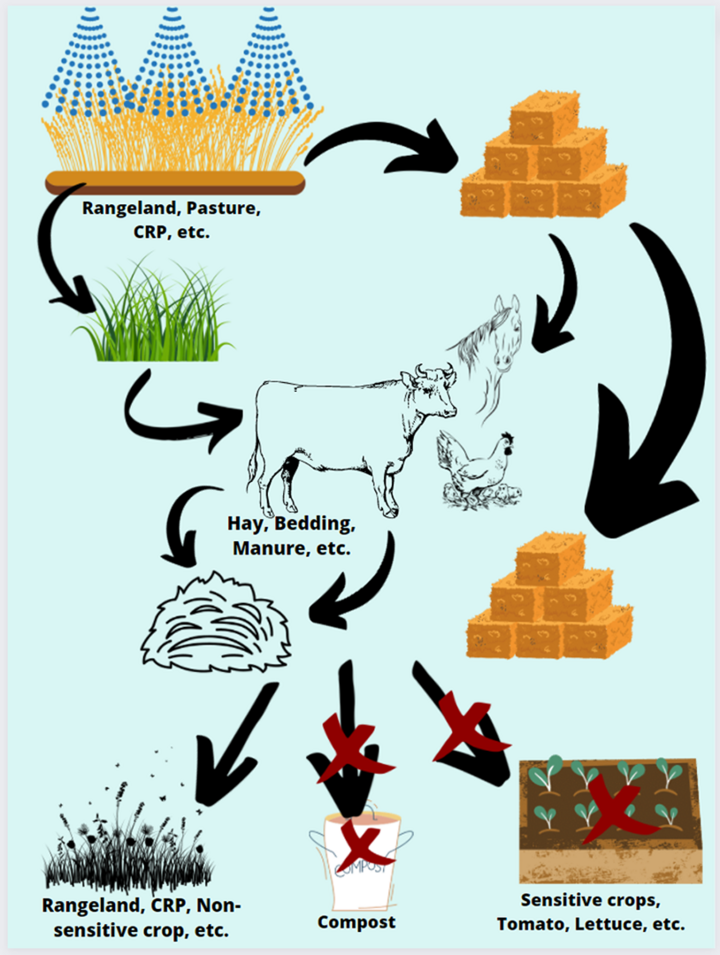The prices of synthetic fertilizers have increased significantly over the last year, leaving growers and even homeowners facing the decision of finding alternative sources of nutrients.
One great option is the use of manure or compost from a local farm or from your own operation. The use of manure in gardening can loosen compacted soil, increase carbon in the soil and reduce surface runoff and leaching, all while providing nutrients that your plants need. While this option is great, it is important to be aware of the potential carryover of herbicides in manure from grazing animals.
Recently, a group of herbicides has been identified as a concern for manure and compost. When herbicides are sprayed onto forages, plants take up the chemicals. If these forages are then utilized as a carbon source in making compost, residues will be present in the finished compost product. Often these same chemicals are used on grazing land. Even though it may be completely safe for grazing livestock to consume the plants, the resulting manure will contain herbicide residues.

Figure 1. Example graphic from a pesticide label with grazing and composting restrictions.
The concern with these herbicide residues in manure and compost is the potential for damaging sensitive plants and crops. Use of manure or compost with these residues present could cause damage to plants, reduce productivity of plants or cause plant death. Additionally, the residues may remain within the soil for an extended period of time if they are present within the manure.
EPA Review of Pyridines
The EPA reviews all registered pesticides at least every 15 years to determine if the chemical is still able to function as intended without negatively affecting human health or the environment. As such, concerns with a product moving off target, not degrading, or causing harm to non-target organisms are often addressed during this review process.
Currently, the EPA is reviewing a group of Pyridines for their persistence in organic matter such as plants, parts of plants, and manure from livestock that have grazed treated plants.
The list of active ingredients being addressed by the EPA for residue concerns in manure and compost from herbicide’s are as follows: Clopyralid, Triclopyr, Fluroxypyr, Aminopyralid, Aminocyclopyrachlor (ACP), Dithiopyr and Picloram.
Before Spraying
Before treating a field for weeds with these active ingredients, determine if you intend to use this field for grazing livestock or if you will use plant residues for compost within the next year. If you do not intend to graze or compost, then many of the concerns regarding pyridines will not apply.
However, if you intend to graze or compost from the treated field, it is especially important to examine the labels of your herbicide for grazing restrictions. Figure 1 shows just one example of what a label might say to indicate that product should not be used anything that will end up grazed or composted.
It may also be useful to look for any of the active ingredients listed above. Older labels may not have grazing restrictions or may have less stringent restrictions on them. Some labels have the grazing restrictions on the first page, but not all, so be sure to look at the Restrictions section of the label and the Use Precautions section for more information.
If you are uncertain on the best plan of action, call your local extension office to connect with an agronomist who can help you determine a plan of action.
Homeowners
If you are planning to use compost or manure from your own yard or a facility, make sure to check any pesticide labels used within the last year. Figure 1 shows just one example of what a label might say to indicate that product should not be used on anything that will end up grazed or composted. You can find the active ingredient list for products on the first page under the section title Active Ingredients.
For homeowners receiving manure or compost from a nearby operation, it is important to ask questions about products that were used to ensure there were no restrictions on movement of the manure.
A list of products that may contain a form of aminopyralid is provided below. This list does not include any herbicides with the active ingredients Clopyralid, Triclopyr, Fluroxypyr, Aminocyclopyrachlor (ACP), Dithiopyr and Picloram, which are also under review for similar reasons. For more information on registered pesticides in Nebraska, check the NDA Pesticide Registrations site.
| Herbicides with Aminopyralid Potassium salt | Herbicides with Aminopyralid, triisopropanolamine salt | Herbicides with Aminopyralid-potassium | Herbicides with Aminopyralid-Tripromine | Herbicides with Triisopropanolamine salt of aminopyralid |
|---|---|---|---|---|
| Chaparral | Capstone | Chaparral | Capstone | Capstone |
| Duracor | ForefrontHL | Duracor | ForefrontHL | ForefrontHL |
| Opensight | Forefront R&P | Opensight | Forefront R&P | Forefront R&P |
| Terravue | GrazonNext HL | Terravue | GrazonNext HL | GrazonNext HL |
| Gunslinger Amp Pasture Herbicide | Gunslinger Amp Pasture Herbicide | Gunslinger Amp Pasture Herbicide | ||
| Milestone | Milestone | Milestone | ||
| Milestone VM plus | Milestone VM plus | Milestone VM plus | ||
| NativeKlean | NativeKlean | NativeKlean | ||
| Pastural L | Pastural L | Pastural L | ||
| Pastural L HL | Pastural L HL | Pastural L HL | ||
| Whetsone Herbicide | Whetsone Herbicide | Whetsone Herbicide |
There are facilities that will test for pesticide residues, but the cost is high and doesn’t provide any recommendations for leftover compost or manure. It’s more important to keep records of what was used even if it’s a general use product and follow the label requirements to reduce the potential for damage of sensitive areas such as yards and gardens.
Interviews with the authors of BeefWatch newsletter articles become available throughout the month of publication and are accessible at https://go.unl.edu/podcast.
